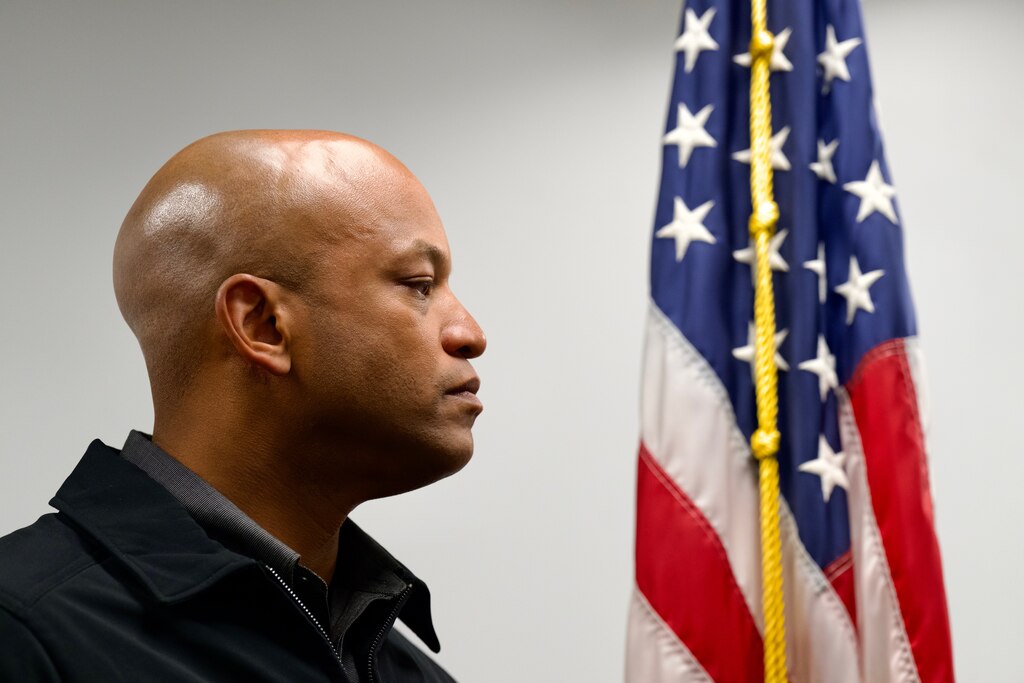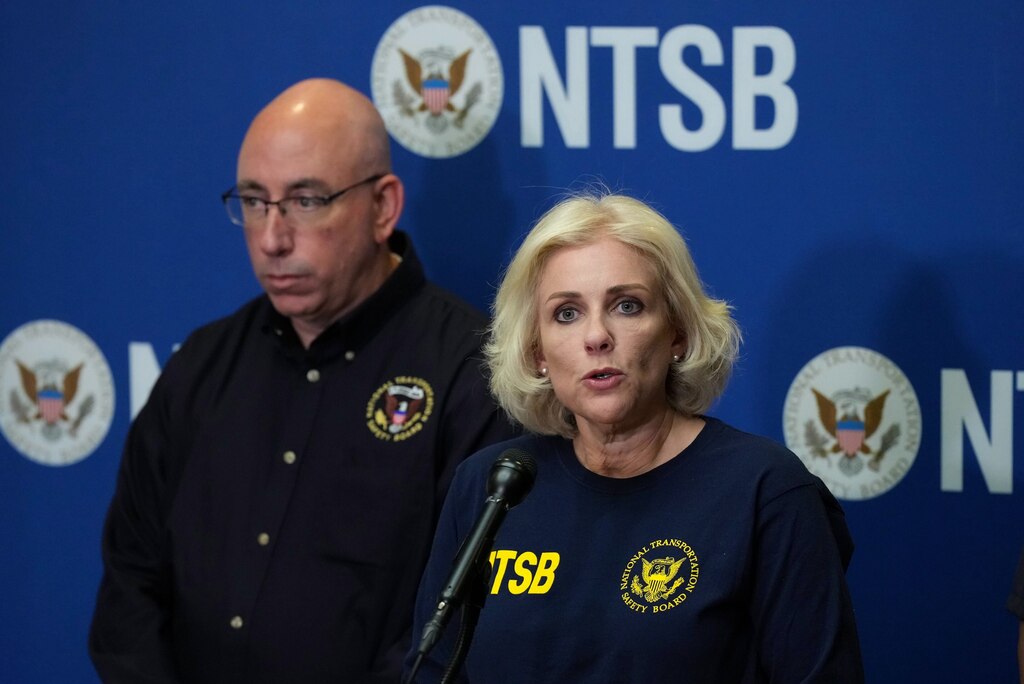The National Transportation Safety Board provided new insight Wednesday night into why the Francis Scott Key Bridge collapsed so suddenly after being struck by a cargo ship that had lost power.
It was a “fracture critical bridge,” meaning if one portion sustained enough damage, the entire structure would collapse, said Jennifer Homendy, chair of the NTSB. Of the roughly 615,000 bridges in the country, about 17,000, or less than 3%, are fracture critical, Homendy said.
”The preferred method for building bridges today is that there is redundancy built in,” she said. “This bridge did not have redundancy.”
At a briefing Wednesday, Homendy also detailed the agency’s investigative process, noting that it has cast a wide net in its search to answer why the cargo ship Dali lost power before it struck the Key Bridge early Tuesday.
The Baltimore Banner thanks its sponsors. Become one.
Investigators are requesting records from myriad state and federal agencies, and have obtained data from the ship’s voyage data recorder, a less-sophisticated cousin of the black boxes found on airplanes.
Also on Wednesday, officials confirmed that the bodies of two construction workers were recovered from the collapse site. But with massive amounts of wreckage and concrete in the water, officials said they could no longer safely search for additional victims without first removing pieces of the bridge.
Read More
Maryland State Police Superintendent Col. Roland L. Butler Jr. said divers found the men trapped inside of a red pickup truck in 25 feet of water. They were identified as Alejandro Hernandez Fuentes, 35, of Baltimore, and Dorlian Ronial Castillo Cabrera, 26, of Dundalk, who were part of a crew fixing potholes when a wayward cargo ship slammed into the bridge.
Butler said the amount of concrete and debris from the bridge rendered additional recovery operations unsafe. Four men remain unaccounted for.
“We are moving from recovery mode to a salvage operation,” Butler said. “We have exhausted all search efforts in the areas around this wreckage, and based on sonar scans we firmly believe the [additional victims] are encased in the superstructure and concrete that we tragically saw come down.”
The Baltimore Banner thanks its sponsors. Become one.
With the recovery effort suspended, Maryland Gov. Wes Moore called for support in rebuilding the bridge and supporting operations at the Port of Baltimore. Moore noted that 8,000 jobs on the docks had been directly affected.
“The collapse of the Key Bridge is not just a Maryland crisis,” Moore said. “The collapse of the Key Bridge is a global crisis.”

There is no timeline for how long it will take to rebuild the bridge.
The investigation, too, is likely to stretch months or years. Homendy said her team expected to be in Baltimore for five to 10 days. While the investigation could take anywhere from 12 to 24 months to complete, she said a preliminary report could be out in two to four weeks.
“We will not hesitate to issue an urgent safety recommendation at any time,” Homendy said.
The Baltimore Banner thanks its sponsors. Become one.
Earlier in the day, Coast Guard Deputy Commandant Vice Adm. Peter Gautier said there were about 4,700 cargo containers on board, a small number of which contained hazardous materials but were not a risk to the public. Two containers went overboard, he said, but do not contain hazardous materials. There was no indication of flooding on the vessel or damage under the water line.
At the evening briefing, NTSB’s Homendy said some of the containers aboard the Dali containing hazardous materials had been breached. When at the scene Wednesday, she and other officials could see “sheen” on the water, indicating some sort of leak or contamination. Cleanup efforts, however, would need to be determined by other agencies, she said.
U.S. Transportation Secretary Pete Buttigieg said federal authorities were processing an emergency relief funding request that had come in from the state transportation department and would be processed “immediately.”
Meanwhile, Buttigieg said he could not give a timeline on reopening the Port of Baltimore, but said Sparrows Point would be able to process some of its capacity. Gautier, of the Coast Guard, said a main challenge to clearing the channel to the port was removing large trusses and the section of roadway from the Dali itself. “About a dozen” vessels have been unable to leave the port.
The economic impact of the disaster is “huge” for the entire country, Moore said. He said the the Port of Baltimore is responsible for $80 billion in foreign cargo and is a major port for cars and farm equipment.
The Baltimore Banner thanks its sponsors. Become one.
“This is not just impacting Maryland. This is impacting that farmer in Kentucky, it is impacting that auto dealer in Michigan,” he said.

A total of six construction workers — who were repairing potholes on the bridge when it collapsed — are presumed dead. Two surviving workers were saved Tuesday. One was hospitalized and since discharged. The other left the scene and refused medical care.
Recovery of the six missing workers began at 6 a.m. Wednesday, led by the state police and in coordination with other agencies. Butler, of the state police, said divers located the bodies around 10 a.m., but it took time to extricate the vehicle using air bags, he said. There was a slow process of then towing the vehicle toward the shoreline, before they ultimately decided to remove the seats from the vehicle.
Fuentes was originally from Mexico; Castillo was from Guatemala, Butler said. One of the men was identified through a driver’s license found in his pocket, while the other was identified through fingerprints.
The situation underwater was particularly dangerous. Supervisory Special Agent Brian Hudson, a program manager with the FBI’s Underwater Search and Evidence Response Team, told WJZ that visibility was minimal. Remotely operated vehicles with cameras and sonar were used to scan the debris.
The Baltimore Banner thanks its sponsors. Become one.
“Rubble is still settling,” Hudson said. “It’s not a great spot for divers, it’s probably blackwater. Sediment get kicked, sediment gets kicked up. And there’s also significant current moving underwater as the tides change.”
Butler said divers from multiple agencies decided no other search and rescue efforts could take place until the bridge was removed. Then, he said, “those same divers are going to go back out there and give people closure.”
Moore ordered flags in Maryland lowered to half-staff until further notice.

The massive container ship Dali struck the Key Bridge after seemingly losing power at 1:24 a.m. on Tuesday. It veered off course a minute later. At some point, the ship issued a mayday that was received by nearby Coast Guard officials and the Maryland Transportation Authority Police were able to stop traffic across the bridge, likely saving lives.
The Maryland Transportation Authority continues to suggest drivers avoid the southeast corridor of I-695. The outer loop of the Beltway is closed at MD 10 (Exit 2) and the inner loop is closed at MD 157/Peninsula Expressway (Exit 43).
The Baltimore Banner thanks its sponsors. Become one.
Banner reporters Hugo Kugiya, Penelope Blackwell and Kristen Griffith contributed to this report.
Correction: This story has been updated to correct the spelling of Maryland State Police Superintendent Col. Roland L. Butler Jr.’s first name, and the name of the FBI Underwater Search and Evidence Response Team.




Comments
Welcome to The Banner's subscriber-only commenting community. Please review our community guidelines.